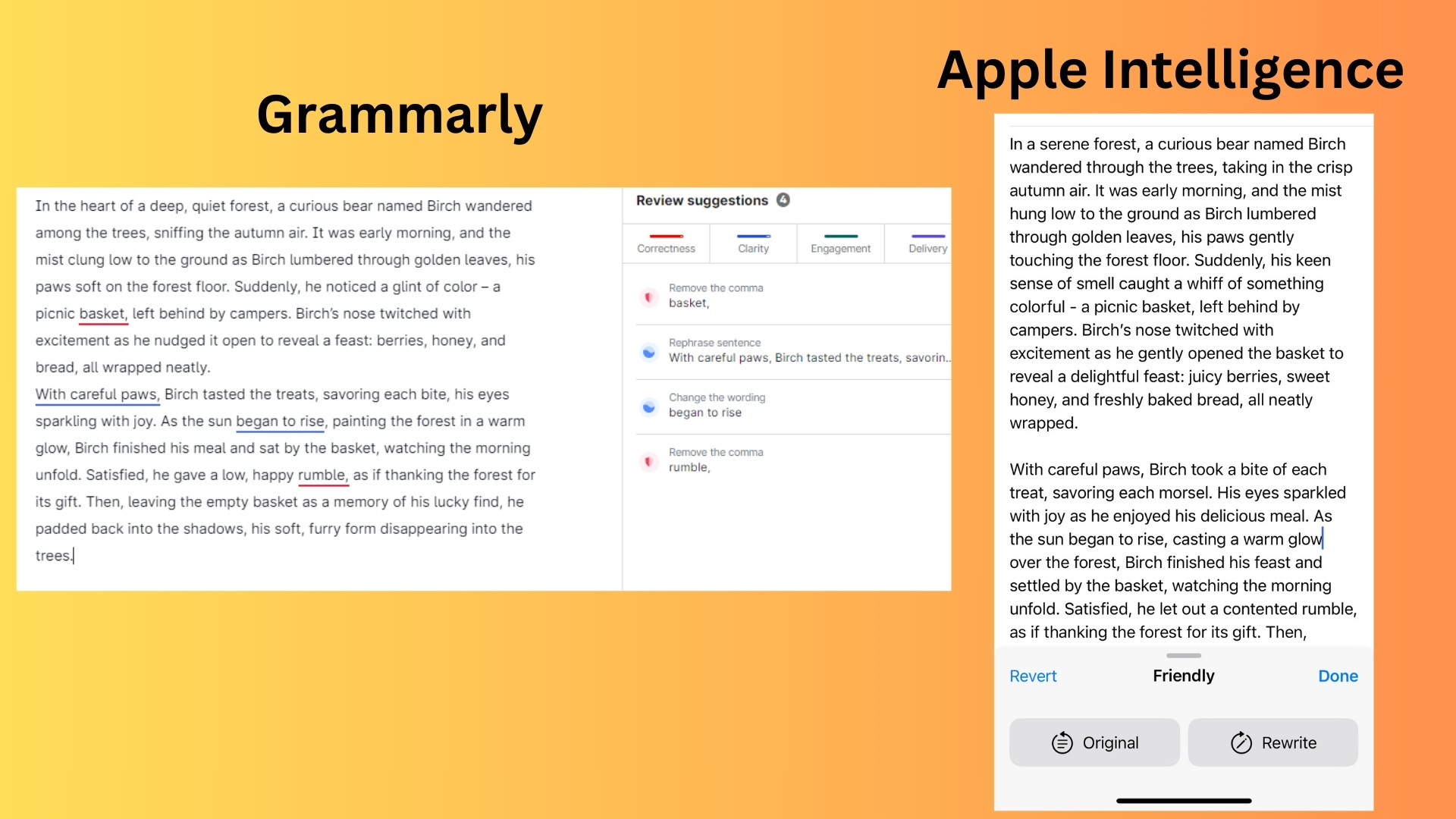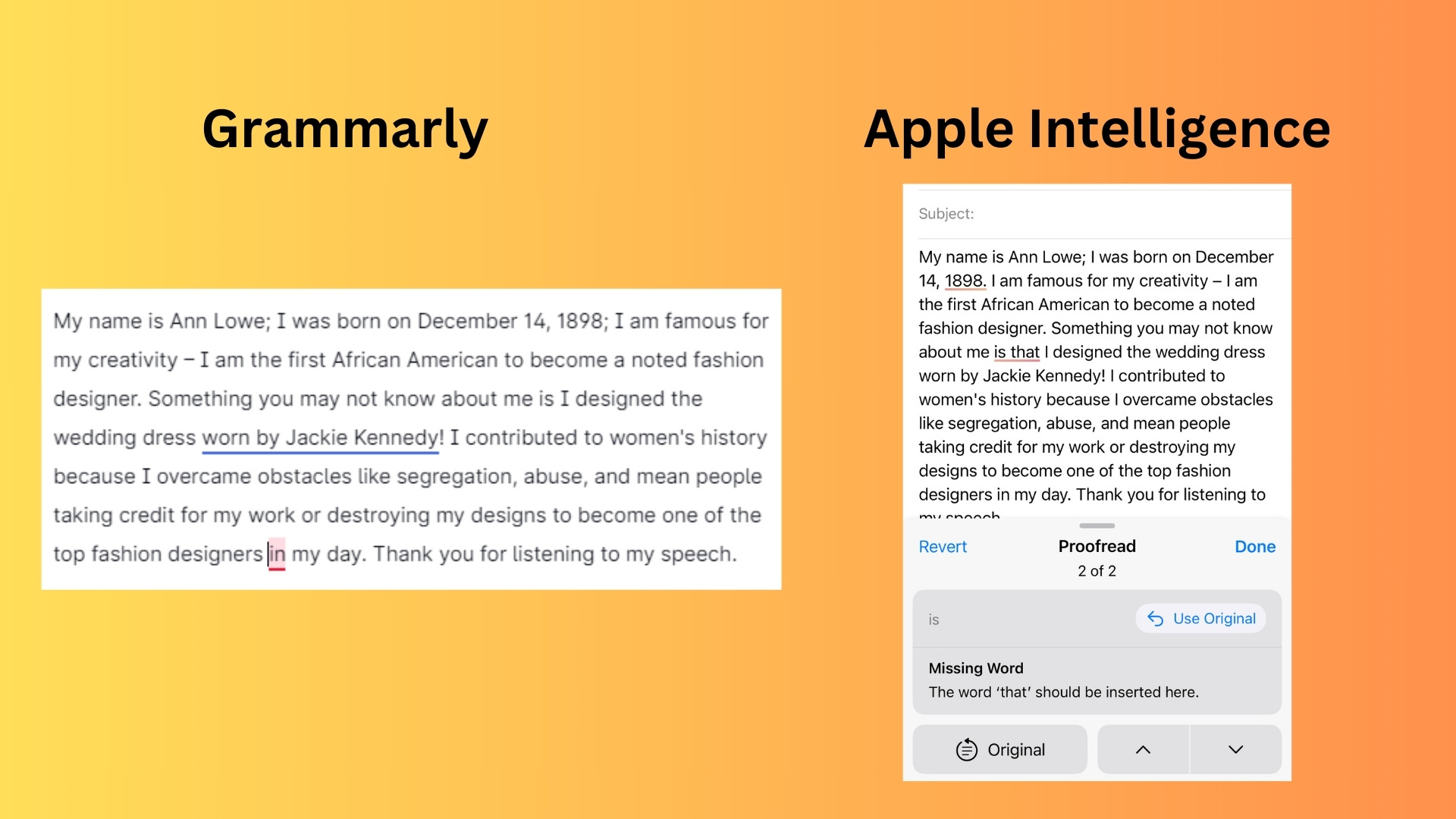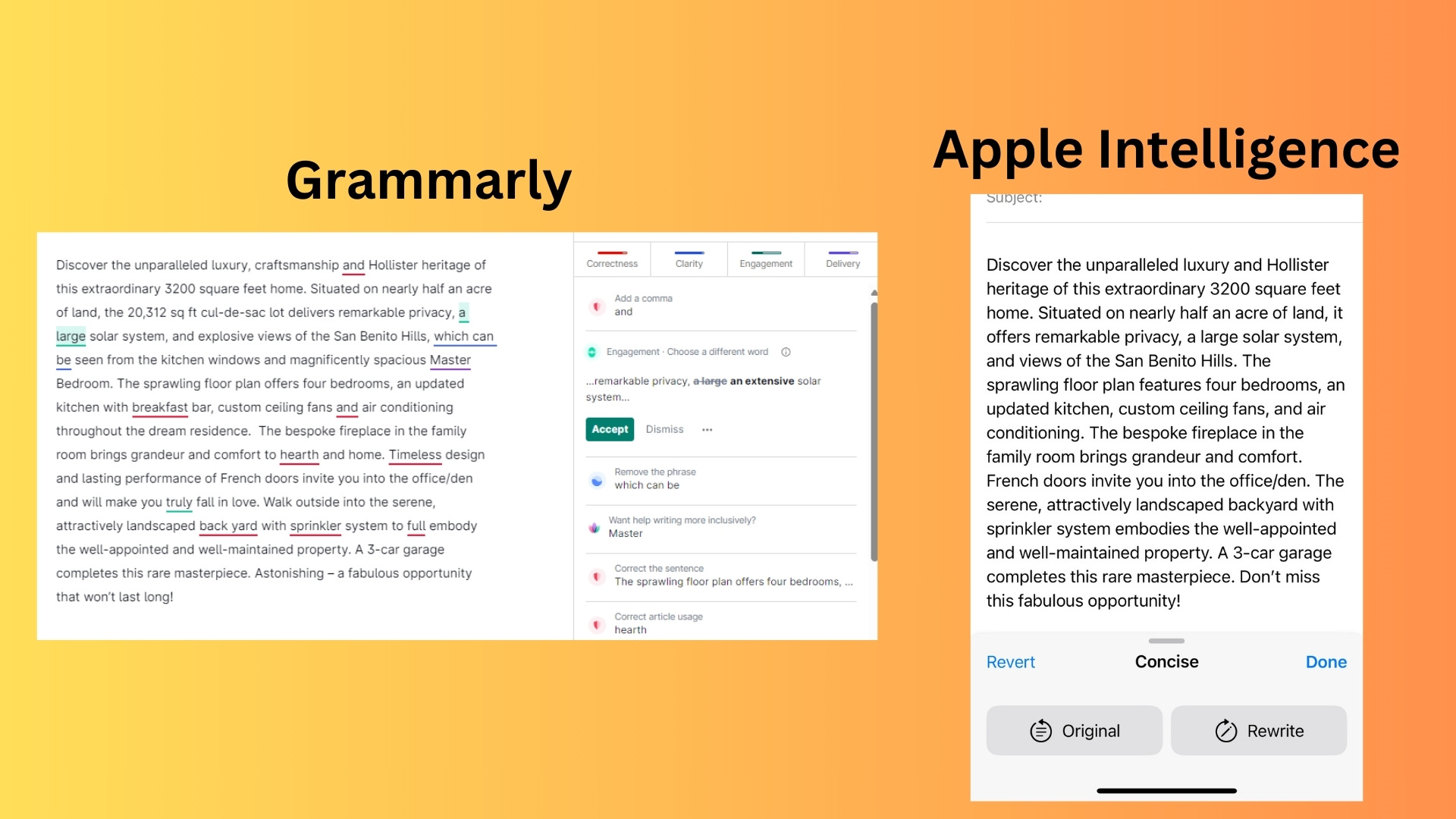I tried 5 writing tasks with Apple Intelligence vs Grammarly — here’s the winner

Because I write all day, every day, I rely on writing tools to correct my grammar, help with sentence structure, and make real-time corrections. When Apple Intelligence first launched and I discovered Apple Writing Tools, I wondered if it would replace Grammarly. At first glance, it seemed as if the two were different enough that I would not have to pick.
However, I decided to put the two players — Apple Intelligence and Grammarly — to the test to see how they compare when editing and refining text. Apple Intelligence is embedded within iOS 18.1 and works seamlessly across Apple devices, while Grammarly has established itself as a robust, platform-agnostic tool for grammar and clarity.
To see how these tools stack up, I tested them both on five common tasks: grammar correction, creative writing support, tone adjustment, contextual feedback, and real-time corrections. Here’s how each tool performed, and why I ultimately found Apple Intelligence to be the better choice.
1. Grammar correction

Grammarly: Notorious for its in-depth and accurate grammar checks; it is, after all, in its name, Grammarly is excellent for catching errors in texts and providing context-based corrections, particularly in complicated sentences. It's capable of finding everything from comma splices to run-on sentences, making it perfect for professional documents. Sometimes, though, Grammarly's suggestions feel a bit too stern, making casual writing more formal than it was supposed to be. I frequently notice that it will take away the tone to the point of creating flat content.
Apple Intelligence: Apple Intelligence, on the other hand, has a more subtle approach to grammar corrections. It doesn’t feel forced like Grammarly and instead feels like a gentle nudge, far less intrusive and better suited for everyday writing. Its grammar checks aren’t as aggressive as Grammarly’s, but that works to its advantage if you want a natural, conversational style without strict adherence to formal grammar rules.
Winner: Apple Intelligence – While Grammarly’s extensive corrections are excellent for formal work, Apple Intelligence provides smoother, more intuitive corrections for day-to-day writing.
2. Creative writing support

Grammarly: Grammarly recently introduced features for creative writing, suggesting rephrased sentences and alternative word choices. While these suggestions can be helpful, as with the grammar suggestions, they often feel too rigid and lack the nuance necessary for a personal touch. This makes Grammarly better suited for clear, direct language rather than creative flair.
Apple Intelligence: Apple Intelligence shines here with its ability to intuitively suggest rephrasing and word choices that align with my unique writing voice. Because it’s embedded in the iOS ecosystem, it adapts more naturally to my personal style, making its creative suggestions feel more organic. This was particularly useful in tasks where I wanted to maintain a distinct tone, like blog posts or social media captions. In other words, Apple Intelligence seems to understand me as a writer and can pick up on the tone and adjust accordingly, Grammarly cannot do that.
Winner: Apple Intelligence – Its natural, style-appropriate suggestions feel less like edits and more like enhancements, making it better for creative writing.
Get instant access to breaking news, the hottest reviews, great deals and helpful tips.
3. Tone adjustment

Grammarly: Grammarly’s tone adjustment feature is extensive, allowing me to adjust for formality, friendliness, and other tones. However, achieving the right tone is time consuming as it involves too much trial and error, and the results seem more formulaic. Grammarly’s tone suggestions are helpful but tend to fall short of creating a truly unique voice.
Apple Intelligence: More intuitive, it seems, Apple Intelligence approaches tone dynamically. Instead of predefined tone settings, it uses contextual cues to adapt tone based on the content. This results in a more natural-sounding outcome that flows well, whether I’m writing an email, drafting a report, or texting a friend.
Winner: Apple Intelligence – Its dynamic tone adjustments felt more intuitive, capturing the nuances of casual, friendly, and professional tones effortlessly.
4. Contextual feedback

Grammarly: Grammarly excels at offering contextual feedback, particularly in longer documents. It identifies passive voice, redundancies, and overly complex phrasing, helping to make text clearer. Again, the contextual understanding is where Grammarly trips up. Grammarly’s feedback can sometimes feel excessive for casual writing, as it pushes for a highly structured approach that isn’t always necessary. In my case, almost never necessary.
Apple Intelligence: Even here, Apple Intelligence takes a subtler approach. Instead of prompting drastic rephrasing, it offers contextual tweaks that help retain a conversational feel. This integration with iOS allows it to pick up on cues from the content’s context, which makes the suggestions feel more in line with how I naturally communicate.
Winner: Apple Intelligence – It provided contextual suggestions that feel conversational and unintrusive, maintaining the natural flow of my writing.
5. Real time corrections

Grammarly: Grammarly’s real time corrections are effective, but they sometimes feel like an added layer rather than a native feature, particularly on mobile. Additionally, real-time corrections occasionally lag when working with longer documents, disrupting the writing flow on mobile.
Apple Intelligence: Real time correction with Apple Intelligence is smooth and responsive, seamlessly integrated across iOS. It feels like a natural extension of autocorrect, responding quickly to typing errors without interrupting my focus. This makes Apple Intelligence my preferred tool when drafting directly on my phone, as it allows for fluid, on-the-go editing.
Winner: Apple Intelligence – Its quick, integrated corrections provided a more seamless experience, especially for mobile writing.
Final verdict
Both Grammarly and Apple Intelligence have unique strengths, but Apple Intelligence ultimately won me over with its seamless iOS integration, subtle suggestions, and adaptive tone adjustments. Grammarly remains a powerhouse for professional, structured editing, especially in business or academic settings. However, for day-to-day tasks and mobile writing, Apple Intelligence offers a smoother, more natural experience.
With Apple Intelligence, I feel less like I am being critiqued and more like I’m offered intuitive assistance that improves my writing without altering my personal style. From creative writing to conversational tone adjustments, Apple Intelligence meets my needs more naturally, enhancing my writing without overpowering it.
More from Tom's Guide
- You can now type to Siri in iOS 18.1 — here's how
- ChatGPT will finally let you search all your old chats — here's how
- I have created thousands of AI images — these are the best AI image generators of 2024

Amanda Caswell is an award-winning journalist, bestselling YA author, and one of today’s leading voices in AI and technology. A celebrated contributor to various news outlets, her sharp insights and relatable storytelling have earned her a loyal readership. Amanda’s work has been recognized with prestigious honors, including outstanding contribution to media.
Known for her ability to bring clarity to even the most complex topics, Amanda seamlessly blends innovation and creativity, inspiring readers to embrace the power of AI and emerging technologies. As a certified prompt engineer, she continues to push the boundaries of how humans and AI can work together.
Beyond her journalism career, Amanda is a long-distance runner and mom of three. She lives in New Jersey.










